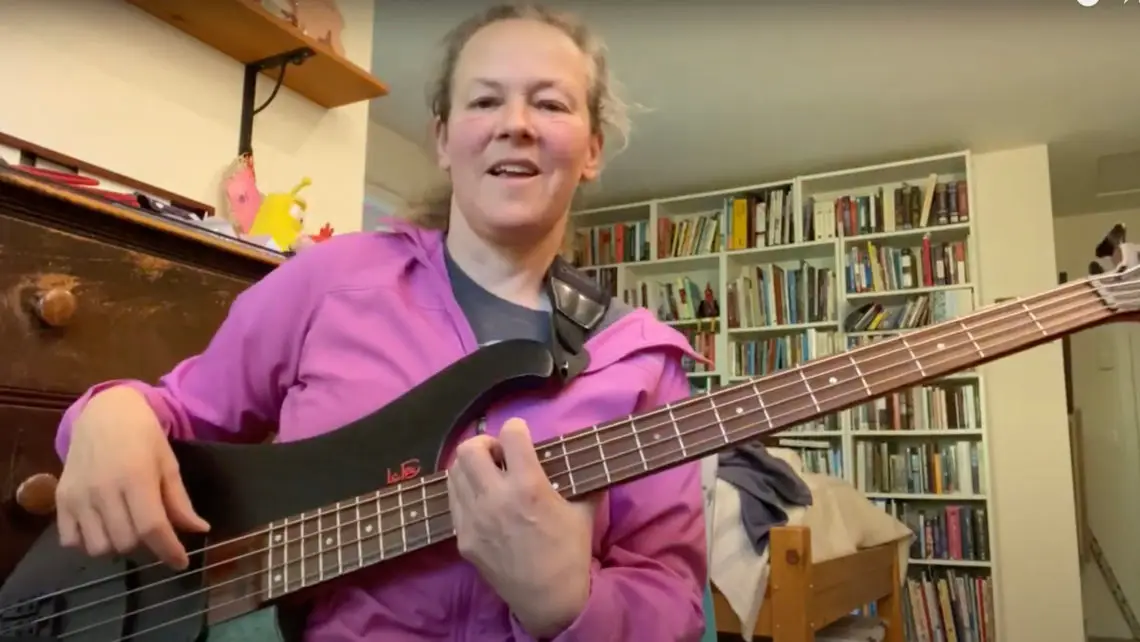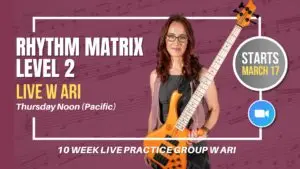Many of my teaching programs incorporate improvisation – and that’s for good reason. When you learn theory as shapes on the fretboard, there is no better way to make those shapes yours – so you can actually use them musically – than to improvise with them.
Watching hundreds of hours of video submissions in our Cohorts and performances in our Practice Groups, I began to notice that while students are doing well learning theory shapes they may not be as successful using them in playing situations and the reason for that was more often than not, issues with rhythm!
For many, rhythm is the missing link. And I mean: the – missing – link.
Learners in all stages may lose connection to the downbeat or get confused, adding or dropping a beat. They realize it, but don’t know how to fix it.
When trying to take a tune off a record, inaccuracy and befuddlement can sometimes set in for unknown reasons.
There is a sense of being “off” – but they cannot pinpoint the cause. Many struggle with upbeat oriented rhythms, syncopation, shuffle-versus-straight and other (important!!!) details.
Rhythmic inaccuracies even hold back experienced players who have reached a creative plateau and don’t know how to break out of their “samey-samey” bass lines.
Have you ever been told to “play less”?
While there is such a thing as overplaying, often times the “play less” directive is the wrong one. Your ideas might be golden, but if they are not grooving (not tight, not synced up with the underlying subdivision) they stick out – and not in a good way. So “play less” is a quick fix at the moment, but won’t make you better in the long run. Much better to fix rhythm and timing issues which will allow your ideas to shine.
The remedy: Rhythm to The Rescue!
My Rhythm Matrix consists of 16 binary rhythmic shapes and 8 ternary ones that – in principle – make up the world of rhythm that you need to know it for most bass playing duties in most common styles. Get a handle on those and your rhythmic creativity, accuracy, and confidence will blossom like never before. What used to hold you back is now a creative asset. The trick is getting them into your body (and out of your head) and I show you how.
Does it work?
One of our students, Tracie, recently completed the 10-week Rhythm Matrix Practice Group (Level 1). She shared these thoughts in our Facebook Group.
I just finished Ari’s Rhythm Course and I can’t stop thinking about how awesome it was. She has come up with such a great way to get the rhythms into your body. I have struggled with syncopation and off beat sixteenth notes for years as a classically trained bassoonist and although I still have a long way to go to get every single subdivision lined up exactly right, I am finally on the right path.
Ari teaches us to feel the subdivisions in our bodies using words. It’s so simple but so deep at the same time. I loved the songs she used to teach us examples from the rhythm matrix and the idea that you can isolate the rhythms from those songs and use them when you are practicing other material. This morning I decided to try that concept with the G Maj pentatonics we are learning in the pattern class (which is also an amazing class). I only started working on this today so it isn’t polished, but I am so excited about the concept of this kind of practice and wanted to share it here. Thanks so much Ariane Cap for your brilliant, creative teaching!!!
She added this video demonstrating how she incorporated her learnings from the Rhythm Matrix class to help her with improvisation. Here she takes a rhythm we featured – the bass line from The Chicken – and improvises with it:
Shape-based learning is not only great for the fretboard, but it also works really well for rhythm too, and I help you feel those rhythms in your body. You cannot “count yourself” into feeling rhythm in the body, but that is exactly where it must reside for you to be able to use it freely. Sure, counting has its place, but try improvising while counting – it just doesn’t work very well at all. Why is that? Simply put, it taps into a different brain hemisphere!
Is rhythm a “missing link” for you?
I have a Rhythm Class like the one Tracie took starting up on March 17th. It runs every Thursday at 10AM (pacific time) for 10 weeks. These are live 1 hour sessions with me and a group of students eager to take their bass playing to a new level. we also have a Level 2 starting if you did Level 1 already.


